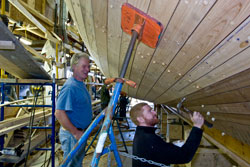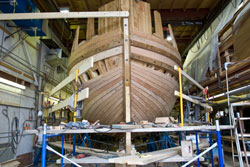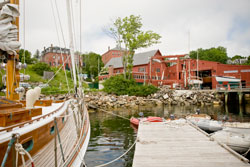Sawdust in Rockport
PROFILE – AUGUST 2008
By Joshua Bodwell
Photography Irvin Serrano
A midcoast boatyard owner with a reverence for wood
Like so many seaside villages on the midcoast, Rockport is cut into a hillside. Off Central Street, a narrow lane plunges down to the harbor and a sprawling complex of red buildings that house Rockport Marine.

This sunny spring morning, the boatyard’s owner, Taylor Allen, is busy—it is the hectic season before the really hectic season. Boats stored at the yard need to be launched, other boats are being overhauled, and new boats are being built. But before Allen can dash around the yard and check the progress of projects, he must spend time in the office with a couple who want to bring up their large sailboat from Grenada for an overhaul.
“That would be almost a winter’s worth of work for us,” says Allen with a hopeful nod as he heads out of the office and rambles downhill toward the yard’s 13,000-square-foot main building. Allen appears too youthful for his head of white hair—but then it befits a man who makes his living from the sea. At 59 years old, his eyes still gleam when he discusses boats and wood.
The shop floor is abuzz. Saws scream and air compressors growl. A few guys push brooms in an attempt to keep the sawdust at bay. The floor is flecked with dots of glue, and the whole place smells of wood. When Allen took over the business from his parents, Luke and Norma, in 1980, there was a staff of just six; now he keeps a crew of fifty busy.
“My folks opened in 1962,” Allen explains, “and Rockport Marine was more of a repair yard and boat-storage operation.” Until 2001, the family also ran the Sail Loft restaurant in what are now the boatyard’s offices. After working for renowned boat designer Joel White, the son of author E.B. White, at the Brooklin Boat Yard, Allen acquired a taste for boat construction. With a psychology degree from Amherst College in his back pocket, he moved Rockport Marine toward full-service boat-building in the early 1980s. One of his first commissions was a collaboration with the Brooklin Boat Yard on a pair of 76-foot day racers from one of Joel White’s last designs. In 1991, having already grown close to the White family, Allen married Joel’s daughter, the writer and editor Martha White.
Looking over the shop, Allen talks about raw slabs of wood with the same reverence that a boating enthusiast might talk about a rare vessel. He points out one massive plank at the top of a large stack. “That is from a 200-year-old white oak that was struck by lightning in a cemetery in western Pennsylvania,” says Allen, his eyes alight. “You don’t find wood like that every day!”
Since Allen moved Rockport Marine toward boat-building, the yard has focused exclusively on wooden boats. “Within the limitations of wood,” he says, “there is endless variety.” Nearly all of the Rockport Marine’s joinery is handled in-house, and their machine shop fabricates stainless-steel and silicone-bronze components.
Continuing to move, Allen bounds up a flight of wooden stairs across a makeshift plank and onto the hulking double-sawn frame of the half-built Adventure. The 53-foot, 50-ton replica of a historic 17th-century colonial trading vessel was commissioned by the State of South Carolina; begun in January, it will be delivered by October. Allen is like a boy in a tree fort, stepping along Adventure’s open frame nearly 30 feet in the air. “A project like this is both a challenge and very interesting,” he says over the thrum of hammers and sanders. “We are not production boatbuilders—we rarely do the same thing twice.”
Scurrying back across the plank, Allen describes a boat much different from Adventure. The 112-foot, three-masted Spirit of Bermuda, which Rockport Marine launched in 2006, used wood-composite technology, carbon-fiber spars, and modern onboard systems.
“Well, you’re all dressed up today!” says a boatbuilder leaning against his workbench, gently jibing Allen.
Allen is bedecked in hiking boots, well-worn jeans rolled once at the cuffs, and a white polo shirt with “Rockport Marine” embroidered in red above the breast. The shirt, however, is tucked in and likely the reason Allen is charged with looking dapper. He takes the needle with a smile and a shake of his head.
Back down on solid ground, Allen has stopped moving like a boat bouncing along the open water. “This can be a feast or famine sort of business,” he admits with a shrug. “So this crew has been very important to me—they have kept me at it all these years.”
Allen stands at the edge of the harbor and looks across Rockport Marine’s docks. Little waves splash against the pier’s green-stained pilings. Lashed to the docks are motorboats, sailboats, and assorted punts, skiffs, and dories. A 1930s-vintage motor sailer bobs at its ropes. The boat is about to move into Rockport Marine’s main bay for what it is to be one of the yard’s most aggressive restoration jobs.
“People had been viewing Maine boat-building in a purely historical context for a long time,” explains Allen. “They hadn’t noticed the high-quality work we’re doing today, they hadn’t seen the passion up here.” That, he says, is changing. The boat-building consortium Maine Built Boats has been spreading the word so effectively that Allen is now getting more European inquires than ever before.
 “Sometimes, when it gets really busy around here, I need to step back and let my crew figure it out,” reflects Allen, turning from the harbor to the cluster of red buildings. A long steam box puffs away, softening wood to curve around the frame of Adventure. The crew bustles about.
“Sometimes, when it gets really busy around here, I need to step back and let my crew figure it out,” reflects Allen, turning from the harbor to the cluster of red buildings. A long steam box puffs away, softening wood to curve around the frame of Adventure. The crew bustles about.
Allen has stopped moving for a moment. “When I go someday,” he says, taking a stride toward the shop, “I want to leave this business thriving.”